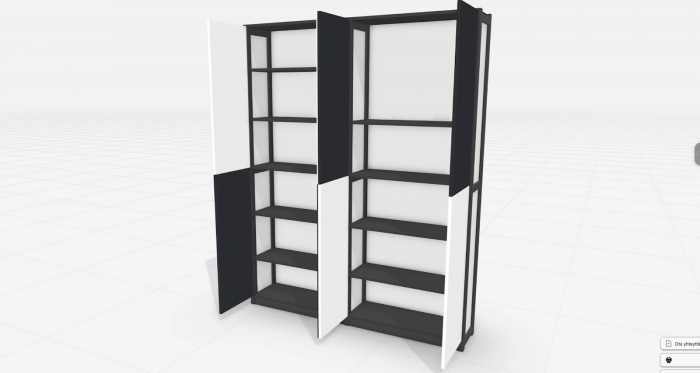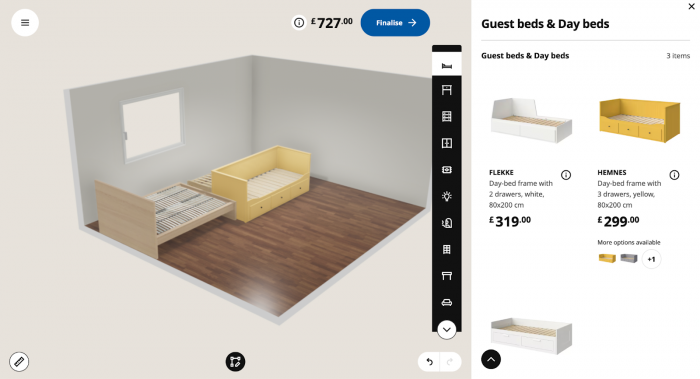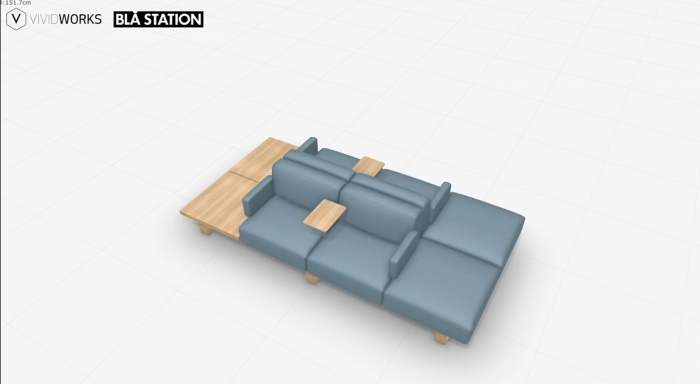Introduction
Converting prospects into buyers is a top priority in a competitive retail fixture landscape. Notably, with custom shelving and modular setups often requiring complex, precise specifications, engaging high-end leads—those ready to purchase—is more important.
If so, what should we start to perform the best performance?
A Deloitte report found that an interactive digital experience that matches the shopper’s needs can lead to a 40% conversion increase, and buyers today prefer personalization. Therefore, it is essential to look for a powerful tool that effectively meets these demands. Product configuration software, especially 3D configurators, is a go-to choice as it lets users visualize and teak fixtures in 3D views in real-time, driving confidence and action.
This article will clarify how 3D configuration software transforms leads for fixture brands. Moreover, you can inspire more ideas and implementation tips from real-world examples.
An Overview of 3D Configuration
Product configuration is the process by which users can freely customize and visualize their own product designs based on their preferences. Therefore, product configuration software is also known as custom software—every personalized idea might be displayed. For retail fixtures, users enjoy building layouts and adjusting materials and dimensions.
Many fixture retailers have adopted 3D configuration, a type of product configuration that levels up the user experience with 360-degree previews. Solutions like the 3D product configurator from VividWorks (https://www.vividworks.com/solutions/3d-product-configurator) allow users to design and monitor every product angle in real-time for accurate evaluations. This is especially key to increasing clarity and trust in purchasing high-modular fixtures, leading to a more active decision-making process—critical for higher conversion rates.
Besides that, advanced features like Visual CPQ, augmented reality (AR), and seamless integration across channels can ensure a clear, smooth buying and selling experience. Solutions offered by companies such as VividWorks not only streamline the fixture customization process but also empower precise data and visuals, reducing miscommunication and speeding up buyer approvals.
How 3D Configurators Improve Leads for Retail Fixture Business
This section will focus on the role of 3D product configuration in boosting lead generation for retail fixture businesses, from simple to complex, tailor-to-order designs.
Let’s take a look at it with our experts below!
1. Enhance customer experience
By allowing for the discovery of products in 360 degrees, 3D configurators can create an impressive experience. Customers can interact with different configurations—adjusting the dimensions of shelving units and swapping out all finishes—without needing support. This apparently makes customers more invested and engaged in their own choices. Consequently, sellers can do better to increase customer satisfaction with their services.
2. Optimize sales processes
When adopting 3D configuration software in their retail fixture store, sellers can streamline workflows by reducing back-and-forth communication. Every step is almost automated: configuration, pricing, and quoting. Even with visual CPQ, 3D configurators can instantly generate accurate quotes based on customer selections and combinations. This efficiency eliminates delays in manual methods, keeping high-intent leads engaged.
3. Reduce sales frictions
Uncertainty is a major challenge in the selling and purchasing process, especially for complex, high-modular products like fixtures. That’s when you need a 3D configurator. This 3D technology is shaping the future of homebuilding, where homeowners consider different interior designs. However, many buyers are restricted to purchasing them online.
Typically, 3D product configuration software can offer a clear, tangible preview of the final designs in 360 degrees, minimizing misunderstandings about dimensions and aesthetics. In addition, the seamless integration with existing systems ensures a smooth transition from exploration to checkout, reducing drop-off rates and boosting lead quality.
Real World Examples: 3D Configurators in Fixture Retailing
Now that I have clarified how 3D configuration benefits the lead generations in retail fixture brands, it’s time to discover some real-world case studies to learn how to start:
Case #1: Lundia
Although a renowned shelve-selling company in Finland, Lundia found it hard to optimize its customer customization experiences for shelving solutions in the early days. The custom shelve manufacturing process is complex and demands back-and-forth exchange between sellers and buyers, which is time-consuming and unexpected errors. This potentially decreased customer satisfaction and slowed down sales retailing cycles.

Lundia utilizes 3D configuration software to offer a better experience in shelving solutions
That’s when Lundia stepped into the software selection for its business—partnering with VividWork to implement a 3D configurator with powerful visual CPQ on its online store. This product configuration tool allows users to customize and explore highly modular, complex storage solutions on their own with 3D views in real-time in a true-to-like space.
Case #2: IKEA
IKEA, one of the leaders in the fixture retailing sector, also uses 3D configuration software for its products, like beds, cabinets, and tables, to improve its lead generation effectively. Buyers can drag and drop fixtures, adjust sizes, and preview their designs in a virtual room. However, the interaction with modular logic might not be found in this configurator.

IKEA stands out with visual CPQ that allows customers to make simple modifications to colors, sizes, and types of fixtures
Case #3: Blå Station
Blå Station is an established Swedish business that specializes in designing seating solutions for offices, lobbies, and airports. While their custom designs engage customers first, reconfiguring components and combinations to match spatial needs takes time. Thus, Blå Station decided to partner with VividWorks to offer a real-time 3D configurator.

Blå Station uses product configuration software to optimize seating solution designs
This product configuration app is highly evaluated for the ability to let users experiment with different design configurations and see accurate prices and quotes instantly. This efficiency can make fixture selection and purchase decisions more informed and efficient.
Conclusion
With this article, we hope you understand the role of 3D product configuration tools in improving high-intent leads for fixture-retailing businesses. Selecting a 3D configurator depends on your specific business demands, but looking for key features like real-time 3D visualizations, seamless integration with existing systems, and visual CPQ is crucial. Don’t forget to visit famous 3D product configurators to inspire ideas for your configurator.
Post Comment
Be the first to post comment!




